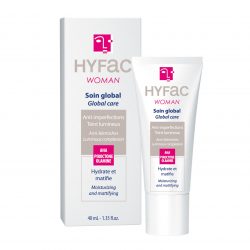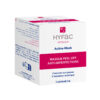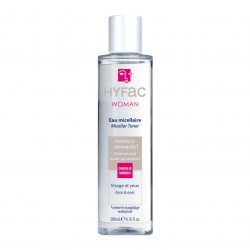
Comprendre et traiter l’acné de la femme adulte
L’acné de la femme adulte est une maladie de la civilisation moderne. De nombreuses femmes s’étonnent d’avoir encore de l’acné à 25 ans. Et pourtant elles sont loin d’être seules !
Acne in adult women has been increasing in frequency in recent years: studies show that about 40% of women complain of acne. Of these, 20% have acne severe enough to require medical treatment.
Qu’est-ce que l’acné de la femme adulte ?
Acne in adult women, like that of the teenageris a chronic illness. Cela signifie qu’elle évolue par poussées pendant plusieurs années. Cela peut durer de l’âge de 20 ans jusqu’à 45 ans. L’acné siège essentiellement sur le visage, bien qu’une forme particulière suive la ligne de la lower jawIt appears as small pimples embedded in the skin, sometimes sensitive. It mixes retentional and inflammatory lesions:
 Retentional lesions:
Retentional lesions:- Closed comedones (microcysts), which are small horny plugs mixed with sebum that block the pores of the skin.
- Open comedones (blackheads)
The formation of comedones is the consequence of the hyperkeratinization of the pilosebaceous follicle. There is an increase in the proliferation of keratinocytes (epidermal cells) leading to the retention of sebum by obstruction of the follicle.
Inflammatory lesions:
- Papules ("red inflammatory "pimples)
- Pustules ("white inflammatory "pimples)
Women's acne is often exaggerated a few days before the menstruation.. It can appear without having manifested itself during adolescence or, more often than not, it can follow, without transition, an acne that appeared at the time of puberty. It is obviously badly experienced by women, altering in a significant way quality of life and self-esteem. It's not easy for a 25-year-old woman to be told she has pimples like her younger brother!
What are the particularities of acne in adult women?
Acne is a sebaceous gland diseaseThe sebaceous gland is a small gland in the dermis responsible for the production of sebum. Sebum is released from the pores of the skin (a cavity in the skin containing a hair follicle and a sebaceous gland), giving it its oily character. This mechanism of sebum secretion is called the seborrhea. The sebaceous glands are very numerous on the face, back and chest.
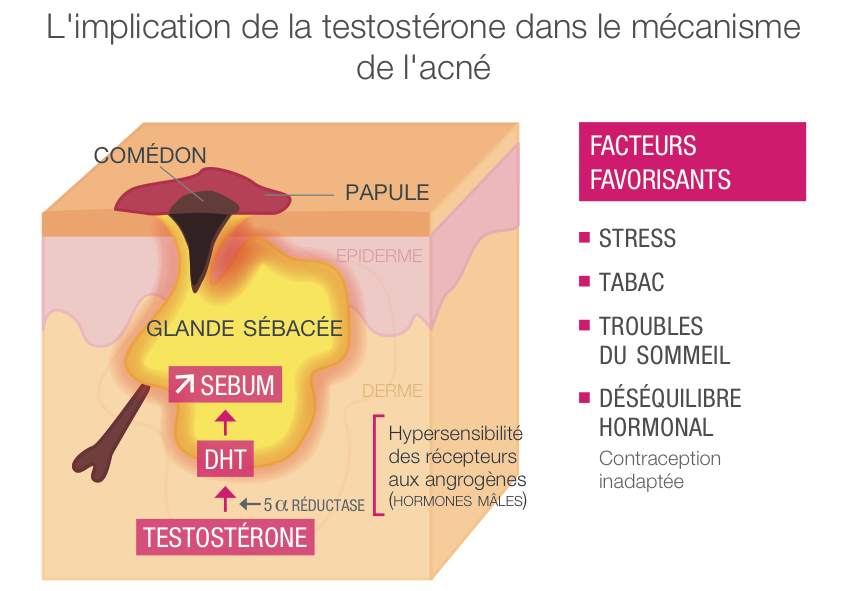
The mechanism of acne in adult women is identical to the adolescent's. As with juvenile acne, there is an increase in seborrhea. In adult women, this increase in seborrhea is the consequence of a particular sensitivity of the sebaceous glands to male hormones (androgens), without usually increasing their production in the body. Women's acne is therefore the result of an exacerbation of the response of these sebaceous glands to normal androgen levels.
Acne is not only unsightly due to the presence of inflamed pimples. It can also leave scars. These are common on the cheeks, giving an "ice pick" appearance to the skin. Acne also leaves pigmented marks on the face, especially on naturally dark skin.
What are the contributing factors?
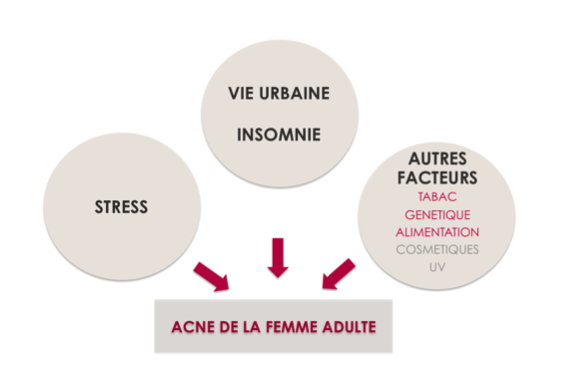
If some favourable factors are well known (hormonal disorders, unsuitable contraception, tobaccos, genetic factors), many of these factors are related to the stress of modern life. Recent studies show an increase in acne in working women with sleep disorders. There is also a high frequency of family history of acne, especially for severe acne.
Modern lifestyles and habits can also encourage the appearance and spread of blemishes. Our smartphonesFor example, our keyboards and tablets are real germ havens that need to be cleaned regularly with disinfectants. Brushes, sponges and other make-up accessories are also in contact with bacteria. Each time you use your skin, these bacteria settle and can clog pores and create blemishes. It is therefore necessary to clean as often as possible.
So what to do?
You must not give up! There are effective treatments. Your dermatologist will first advise you toact on the factors that encourage it that we have cited (have you considered stopping the cigarette ? what contraception do you use ? Are you stressed ?). He will be able to suggest treatments to act on the excessive functioning of the sebaceous glands, to correct the inflammation, to reduce the formation of blackheads. Whatever the treatmentThe treatment must be continued for a sufficiently long time. This is essential given the chronic nature of acne.
In parallel with the treatments, whether local or medicated, a strict hygiene is also recommended, the make-up removal is essential. The skin must be clean and free of all impurities (dead cells, dust, pollution debris and leftovers of make-up). Acne-prone skin is fragile and sometimes irritated by treatments. softness. Before you start, make sure your hands and nails are clean. Hand hygiene is essential to avoid infection and the multiplication of acne pimples.
L’acné, lorsqu’elle est sévère, peut laisser sur le visage, le dos ou le décolleté des permanent scars parfois importantes. C’est une des raisons pour lesquelles les acnés sévères doivent être traitées sans attendre. Les acnés plus modérées laissent souvent des marques rouges qui disparaitront au fil du temps. Cependant, même dans le cas d’acnés légères, des cicatrices définitives peuvent apparaitre lorsqu’on s’acharne sur les boutons en les grattant, ou en les pressant entre les doigts. Mieux vaut les assécher avec un patch left in place all night.
If you already have scarsYou can use oils or creams based on natural active ingredients that can alleviate them. There is also make-up to blur or camouflage imperfections. Ask your pharmacist for advice; he or she will know which products to use according to your skin type.




 Retentional lesions:
Retentional lesions: